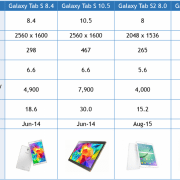Samsung Electronics’ Display Business Operating Profit in 1Q 2018 slowed down to KRW 410 billion
Samsung Electronics reported sales of KRW 60.56 trillion and operating profit of KRW 15.64 trillion in the first quarter of 2018 at the conference held on April 26. Its display division generated sales of KRW7.54 trillion with the operating profit of KRW410 billion. Display sales QoQ and YoY are -32.6% and 3.4%, respectively, and operating profit QoQ and YoY are -70.9% and -68.5%, respectively. OLED sales accounted for 70% of its total display sales. According to Samsung Electronics, the profitability of OLED segment in the first quarter of 2018 declined due to a decrease in demand from major customers and intensified competition with LTPS LCD for rigid OLED. In spite of the downturn in sales due to seasonal weakness and the decline in panel prices, LCD division achieved similar profitability as the previous quarter, thanks to the increased sales portion of high value-added products such as large-size and UHD and continuous cost reductions.
OLED demand is expected to continue to decline in the second quarter of 2018, and Samsung Electronics plans to expand its customer base while striving to secure competitiveness through cost reduction and production efficiency improvement. Although LCD segment is also expected to continue to show oversupply in 2Q 2018 due to the launch of new LCD lines, Samsung Electronics plans to secure profitability through timely development of high value-added and differentiated products, and cost reduction activities. Samsung Electronics said the demand of OLED panels for mobile devices is anticipated to gradually recover in the second half of 2018, while flexible products are expected to be the main focus of premium products. Also it emphasized that Samsung will expand its market share by expanding customer base through new technologies and new products, and strengthening cost competitiveness, together with technology differentiation with LCD and enhancement of new applications capacity. For the LCD segment, uncertainties are to be increased as Chinese panel makers continue to expand production volumes with the fierce competitions competition among companies. Samsung mentioned that it will continue to focus on differentiating with the large and high-end premium products and strengthening strategic partnerships with major customers to secure profitability. In the first quarter of 2018, Samsung Electronics sold 86 million mobile phones and 5 million tablets. The sales for mobile phone sales in Q2 2018 are expected to decline compared to the previous quarter, and tablet sales are expected to maintain the level of the previous quarter.
Total investment of Samsung Electronics in the first quarter of 2018 was 8.6 trillion won, of which 0.8 trillion won was invested in the display. Although the investment plan for this year has not been finalized yet, it is expected to decline from 2017 due to the rapid expansion of flexible OLED production, new technology development, and facility investment to prepare for market growth last year. Choi Kwon-Young, Vice President of Samsung Display said, “Currently, the mass production of A4 line is ready for operation in accordance with the agreed schedule with the customer. And A3 line is trying to minimize the drop in operation rate.” He continued “We are under development by focusing on Quantum dot and 8K technologies to meet customer needs for big screen TV market. Also we are interested in various next-generation display technologies including micro LED.”
Samsung Electronics has continued research and development for the commercialization of foldable phone, and now it is working with various companies to improve the product’s completeness.” Samsung said. Further, it added “We are focusing on improving the completeness of the product so that it can give real value to the consumers rather than simply launching it for the first time in the world. If the parts performance and durability for the implementation of the foldable phone are more stabilized, and various use cases are found with the emergence of new form factor, we will disclose separately the timing of its commercialization.”











